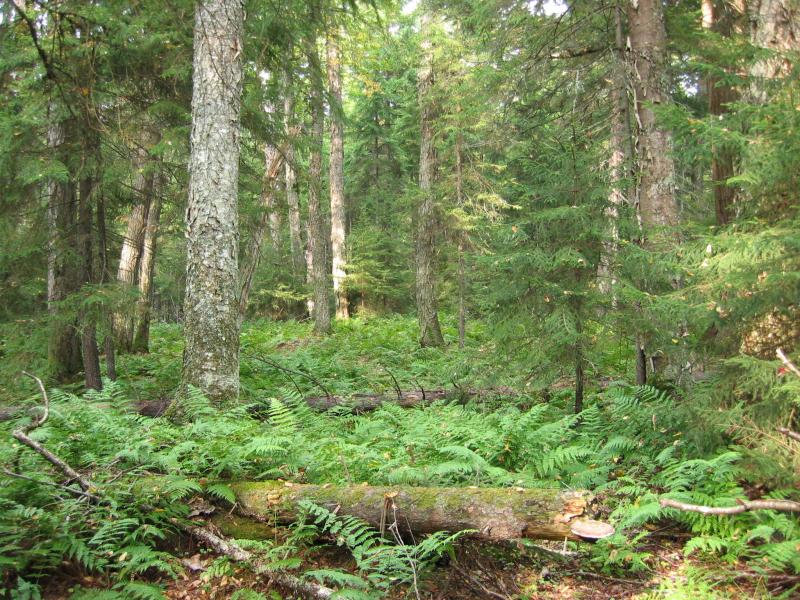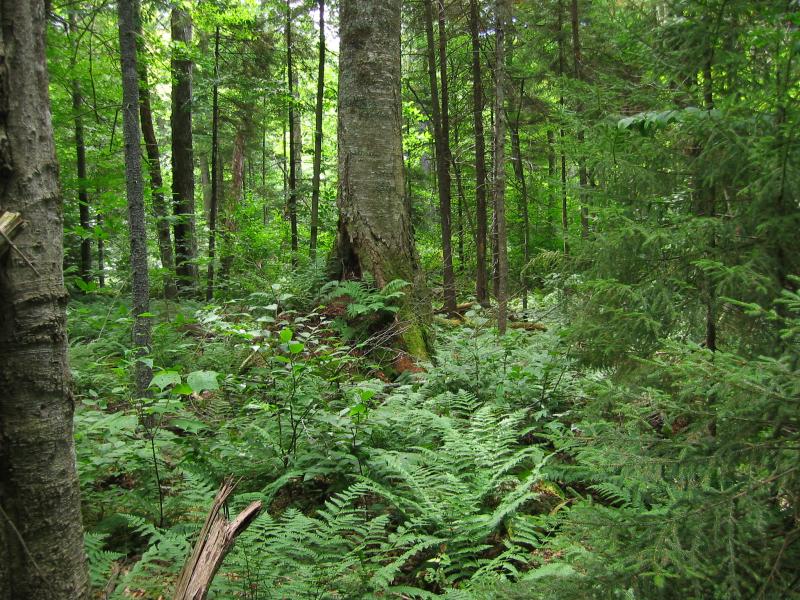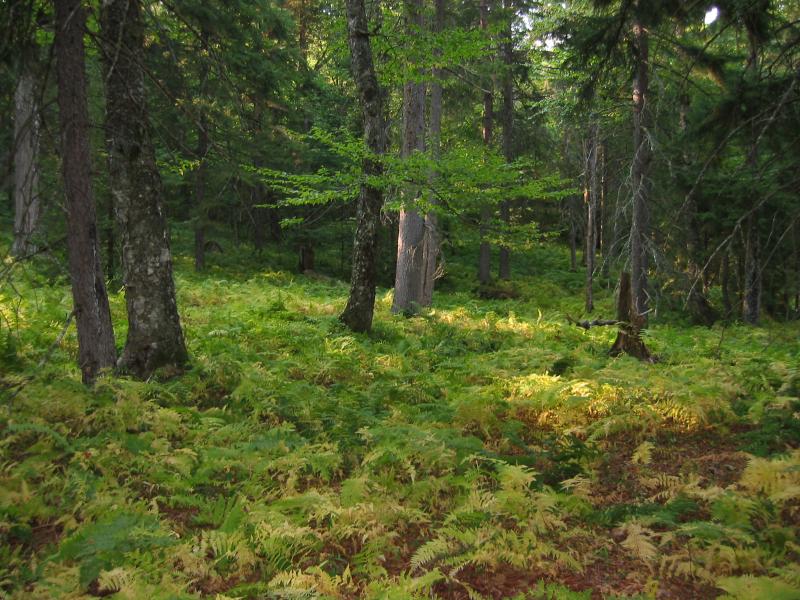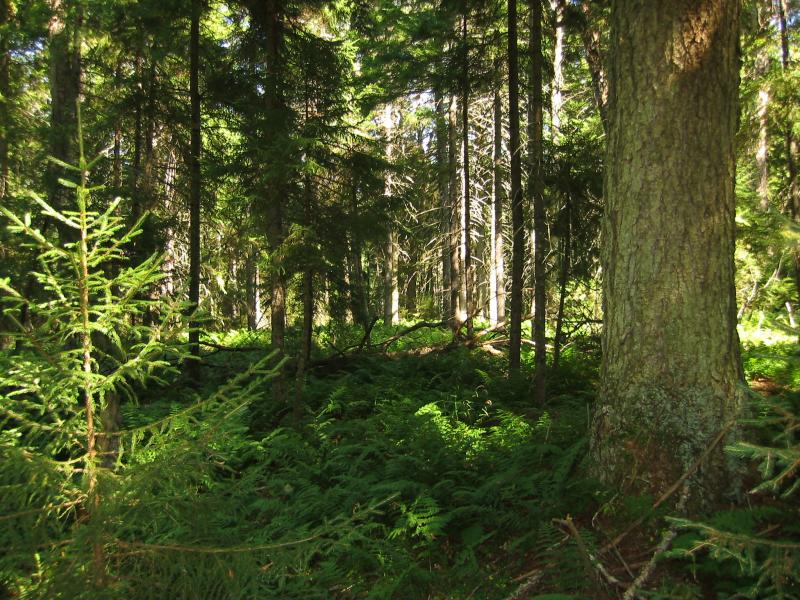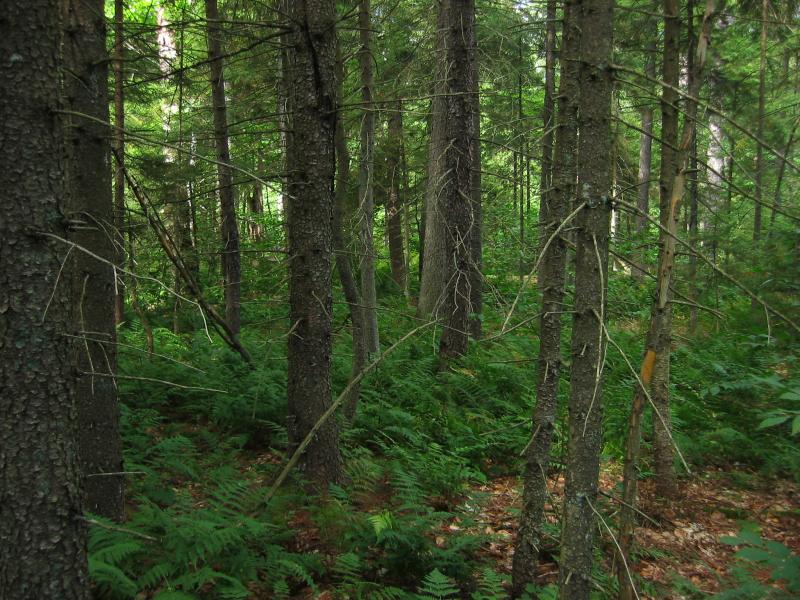Spruce-Northern Hardwood Forest
- System
- Terrestrial
- Subsystem
- Forested Uplands
- State Protection
- Not Listed
Not listed or protected by New York State.
- Federal Protection
- Not Listed
- State Conservation Status Rank
- S3S4
Vulnerable in New York, or Apparently Secure - Vulnerable to disappearing from New York (but not currently imperiled), with relatively few populations or locations, few individuals, and/or restricted range; or uncommon but not rare in New York; may be rare in some parts of the state; possibly some cause for long-term concern due to declines or other factors. More information is needed to assign either S3 or S4.
- Global Conservation Status Rank
- G3G4
Vulnerable globally, or Apparently Secure - At moderate risk of extinction, with relatively few populations or locations in the world, few individuals, and/or restricted range; or uncommon but not rare globally; may be rare in some parts of its range; possibly some cause for long-term concern due to declines or other factors. More information is needed to assign either G3 or G4.
Summary
Did you know?
A common plant in spruce-northern hardwood forests is gold thread, which takes its name from its golden, thin, root-like rhizomes. Native Americans and early settlers used gold thread rhizomes and leaves to dye cloth yellow.
State Ranking Justification
There are several hundred occurrences statewide. A few documented occurrences have good viability and several are protected on public land or private conservation land. This community has a very limited statewide distribution and includes several very large, high quality, old-growth examples. The current trend of this community is probably stable for occurences on public land and private conservation land, or declining slightly elsewhere due to moderate threats related to intensive logging, acid rain deposition, and development pressure.
Short-term Trends
The number and acreage of spruce-northern hardwood forests in New York have probably declined moderately in recent decades as a result of intensive logging, agriculture, and development.
Long-term Trends
The number and acreage of spruce-northern hardwood forests in New York have probably declined substantially from historical numbers, likely correlated with past logging, agiculture, and other development.
Conservation and Management
Threats
Threats to forests in general include changes in land use (e.g., clearing for development), forest fragmentation (e.g., roads, intensive logging), and invasive species (e.g., insects, diseases, and plants). Other threats may include over-browsing by deer, fire suppression, and air pollution (e.g., ozone and acidic deposition). Examples of this community that occur at higher elevations (e.g., >3,000 feet) may be more vulnerable to the adverse effects of atmospheric deposition and climate change, especially acid rain and temperature increase. When occurring as expansive forests, the largest threat to the integrity of spruce-northern hardwood forests are activities that fragment the forest into smaller pieces. These activities, such as road building and other development, restrict the movement of species and seeds throughout the entire forest, an effect that often results in loss of those species that require larger blocks of habitat (e.g., black bear, bobcat, certain birds). Additionally, fragmented forests provide decreased benefits to neighboring societies of services these societies often substantially depend on (e.g., clean water, mitigation of floods and droughts, pollination in agricultural fields, and pest control) (Daily et al. 1997). Spruce budworm may be considered a threat to occurrences of spruce-northern hardwood forest that experience extreme outbreaks, especially if it coincides with other stresses and reduces tree regeneration. The spruce budworm (Choristoneura fumiferana) is a native insect that creates canopy gaps in spruce and fir forests of the Eastern United States and Canada. Since 1909, there have been waves of budworm outbreaks throughout the Eastern United States and Canada. The states most often affected are Maine, New Hampshire, New York, Michigan, Minnesota, and Wisconsin (Kucera and Orr 1981). Balsam fir is the is the primary host tree for budworm in the Eastern United States, although white, red, and black spruce are known to be suitable host trees. Spruce budworm may also feed on tamarack, pine, and hemlock. Spruce mixed with balsam fir is more likely to show signs of budworm infestation than spruce in pure stands (Kucera and Orr 1981). Spruce-northern hardwood forests at higher elevations may be threatened by acid rain deposition. The ability of forest soils to resist, or buffer, acidity depends on the thickness and composition of the soil, as well as the type of bedrock beneath the forest floor. Places in the mountainous northeast, like New York's Adirondack and Catskill Mountains, have thin soils with low buffering capacity. Forests in high mountain regions often are exposed to greater amounts of acid than other forests because they tend to be surrounded by acidic clouds and fog that are more acidic than rainfall. When leaves are frequently bathed in this acid fog, essential nutrients in their leaves and needles are stripped away. This loss of nutrients in their foliage makes trees more susceptible to damage by other environmental factors, particularly cold winter weather (US EPA 2005).
Conservation Strategies and Management Practices
Management should focus on activities that help maintain regeneration of the species associated with this community. Deer have been shown to have negative effects on forest understories (Miller et al. 1992, Augustine & French 1998, Knight 2003) and management efforts should strive to ensure that regenerating trees and shrubs are not so heavily browsed that they cannot replace overstory trees when required to do so. Avoid cutting old growth examples and encourage selective logging areas that are under active forestry.
Development and Mitigation Considerations
Strive to minimize fragmentation of large forest blocks by focusing development on forest edges, minimizing the width of roads and road corridors extending into forests, and designing cluster developments that minimize the spatial extent of the development. Development projects with the least impact on large forests and all the plants and animals living within these forests are those developments built on brownfields or other previously developed land. These projects have the added benefit of matching sustainable development practices (for example, see: The President's Council on Sustainable Development 1999 final report, US Green Building Council's Leadership in Energy and Environmental Design certification process at http://www.usgbc.org/).
Inventory Needs
Inventory any remaining large and/or old-growth examples across the state. Continue searching for large sites in good condition (A- to AB-ranked).
Research Needs
Research the composition and collect sufficient plot data for spruce-northern hardwood forests statewide in order to characterize variations and clearly separate this community from spruce flats and balsam flats. Regularly assess the presence and degree of impact that spruce budworm has on this community.
Rare Species
- Cypripedium arietinum (Ram's Head Lady's Slipper) (guide)
- Epilobium hornemannii ssp. hornemannii (Alpine Willowherb) (guide)
- Galium kamtschaticum (Northern Wild Licorice) (guide)
- Haliaeetus leucocephalus (Bald Eagle) (guide)
- Lasionycteris noctivagans (Silver-haired Bat) (guide)
- Lasiurus cinereus (Hoary Bat) (guide)
- Myotis lucifugus (Little Brown Bat) (guide)
- Myotis septentrionalis (Northern Long-eared Bat) (guide)
- Viburnum edule (Squashberry) (guide)
Range
New York State Distribution
This community is limited to the northern portion of the state and areas of high elevation elsewhere. It is concentrated in the Northern Appalachian Ecoregion of the Adirondack Mountains, where it forms the matrix forest, and Tug Hill Plateau. It is also common in the Saint Lawrence and Lake Champlain Lowlands of the Great Lakes Ecoregion. It is peripheral in the High Allegheny Plateau and Lower New England Ecoregions, where it occurs in small patches, from the Catskill Peaks, Rensselaer Plateau and Northern Taconic Mountains.
Global Distribution
This community is suspected to span north to southern Quebec, southwest to the Catskill Mountains of New York, southeast to the Berkshire Mountains of Massachusetts, and northeast to Nova Scotia.
Best Places to See
- Catskill Park (Greene, Ulster Counties)
- Dix Mountain Wilderness Area, Adirondack Park
- Grafton Lakes State Park (Rensselaer County)
- Adirondack Park (Hamilton County)
Identification Comments
General Description
Spruce-northern hardwood forest is a mixed forest that occurs on lower mountain slopes and upper margins of flats on glacial till. This is a broadly defined community with several regional and edaphic variants; it is one of the most common forest types in the Adirondacks. Codominant trees are red spruce (Picea rubens), sugar maple (Acer saccharum), American beech (Fagus grandifolia), yellow birch (Betula alleghaniensis), and red maple (Acer rubrum), with scattered balsam fir (Abies balsamea). Striped maple (Acer pensylvanicum) and mountain maple (A. spicatum) are common subcanopy trees. Characteristic shrubs are hobblebush (Viburnum lantanoides), American fly honeysuckle (Lonicera canadensis), and Canada yew (Taxus canadensis). Characteristic groundlayer plants are common wood-sorrel (Oxalis montana), common wood fern (Dryopteris intermedia), shining fir clubmoss (Huperzia lucidula), wild sarsaparilla (Aralia nudicaulis), bluebeads (Clintonia borealis), goldthread (Coptis trifolia), bunchberry (Cornus canadensis), Canada mayflower (Maianthemum canadense), Indian cucumber-root (Medeola virginiana), and twisted stalk (Streptopus roseus). Characteristic birds include yellow-bellied flycatcher (Empidonax flaviventris), white-throated sparrow (Zonotrichia albicollis), golden-crowned kinglet (Regulus satrapa), pileated woodpecker (Dryocopus pileatus), and gray jay (Perisoreus canadensis) (Edinger et al. 2002).
Characters Most Useful for Identification
In the Adirondacks and Catskills the spruce-northern hardwood forests generally occur in the transition zone between lower elevarion beech-maple mesic forests and the higher elevation mountain spruce-fir forests. The spruce trees usually have at least 25% cover and tend to be tall and straighter than the spruce in higher elevation communities that are exposed to wind stress.
Elevation Range
Known examples of this community have been found at elevations between 1,340 feet and 3,770 feet.
Best Time to See
Several wildflower species of spruce-northern hardwood forests can be observed in bloom throughout the spring and summer. During the spring, flowers of bluebead lily (Clintonia borealis), and Canada mayflower (Maianthemum canadense) appear on the forest floor, followed by bunchberry (Cornus canadensis), goldthread (Coptis trifolia), and wood-sorrel (Oxalis montana).
Spruce-Northern Hardwood Forest Images
Classification
International Vegetation Classification Associations
This New York natural community encompasses all or part of the concept of the following International Vegetation Classification (IVC) natural community associations. These are often described at finer resolution than New York's natural communities. The IVC is developed and maintained by NatureServe.
- Red Spruce - American Beech - Yellow Birch / Hobblebush Forest (CEGL006267)
NatureServe Ecological Systems
This New York natural community falls into the following ecological system(s). Ecological systems are often described at a coarser resolution than New York's natural communities and tend to represent clusters of associations found in similar environments. The ecological systems project is developed and maintained by NatureServe.
- Acadian-Appalachian Montane Spruce-Fir Forest (CES201.566)
Characteristic Species
-
Trees > 5m
- Acer rubrum var. rubrum (common red maple)
- Acer saccharum (sugar maple)
- Betula alleghaniensis (yellow birch)
- Betula papyrifera (paper birch)
- Fagus grandifolia (American beech)
- Picea rubens (red spruce)
- Pinus strobus (white pine)
- Tsuga canadensis (eastern hemlock)
-
Shrubs 2 - 5m
- Acer pensylvanicum (striped maple)
- Acer spicatum (mountain maple)
-
Shrubs < 2m
- Lonicera canadensis (American fly honeysuckle)
- Taxus canadensis (Canada yew, American yew)
- Vaccinium myrtilloides (velvet-leaved blueberry)
- Viburnum lantanoides (hobblebush)
-
Herbs
- Aralia nudicaulis (wild sarsaparilla)
- Brachyelytrum erectum (southern shorthusk)
- Clintonia borealis (blue bead-lily)
- Coptis trifolia (gold-thread)
- Cornus canadensis (bunchberry)
- Dennstaedtia punctilobula (hay-scented fern)
- Diphasiastrum digitatum (southern ground-cedar)
- Dryopteris carthusiana (spinulose wood fern)
- Dryopteris intermedia (evergreen wood fern, fancy wood fern, common wood fern)
- Huperzia lucidula (shining firmoss)
- Lysimachia borealis (starflower)
- Maianthemum canadense (Canada mayflower)
- Medeola virginiana (Indian cucumber-root)
- Oxalis montana (northern wood sorrel)
- Streptopus lanceolatus (rose twisted stalk, rose mandarin)
Similar Ecological Communities
- Beech-maple mesic forest
(guide)
Beech-maple mesic forests are dominated by northern hardwoods and typically occur at lower elevations than spruce-northern hardwood forests. Spruce is present at low percent cover or absent in beech-maple mesic forests.
- Hemlock-northern hardwood forest
(guide)
Hemlock-northern hardwood forests have significant hemlock cover (at least 20%), whereas spruce-northern hardwood species feature higher densities of spruce, with hemlock scarce or absent.
- Mountain fir forest
(guide)
Mountain fir forests are situated at higher elevations than spruce-northern hardwood forests, and they feature a canopy made up almost entirely of balsam fir.
- Mountain spruce-fir forest
(guide)
Mountain spruce-fir forests are situated at higher elevations than spruce-northern hardwood forests, and they feature a canopy made up primarily of spruce and fir, with fewer northern hardwood species.
Vegetation
Percent cover
This figure helps visualize the structure and "look" or "feel" of a typical Spruce-Northern Hardwood Forest. Each bar represents the amount of "coverage" for all the species growing at that height. Because layers overlap (shrubs may grow under trees, for example), the shaded regions can add up to more than 100%.
Additional Resources
References
Augustine, A.J. and L.E. French. 1998. Effects of white-tailed deer on populations of an understory forb in fragmented deciduous forests. Conservation Biology 12:995-1004.
Daily, G.C., S. Alexander, P.R. Ehrlich, L. Goulder, J. Lubchenco, P. Matson, H.A. Mooney, S. Postel, S.H. Schneider, D. Tilman, and G.M. Woodwell. 1997. Ecosystem Services: benefits supplied to human societies by natural ecosystems. Issues In Ecology 2:1-16.
Edinger, G. J., D. J. Evans, S. Gebauer, T. G. Howard, D. M. Hunt, and A. M. Olivero (editors). 2014. Ecological Communities of New York State. Second Edition. A revised and expanded edition of Carol Reschke’s Ecological Communities of New York State. New York Natural Heritage Program, New York State Department of Environmental Conservation, Albany, NY. https://www.nynhp.org/ecological-communities/
Edinger, Gregory J., D.J. Evans, Shane Gebauer, Timothy G. Howard, David M. Hunt, and Adele M. Olivero (editors). 2002. Ecological Communities of New York State. Second Edition. A revised and expanded edition of Carol Reschke's Ecological Communities of New York State. (Draft for review). New York Natural Heritage Program, New York State Department of Environmental Conservation. Albany, NY. 136 pp.
Eyre, F.H., ed. 1980. Forest cover types of the United States and Canada. Society of American Foresters, Washington, D.C.
Heimburger, C.C. 1934. Forest-type studies in the Adirondack Region. Cornell University Experiment Station Memoir 165, Ithaca, New York.
Irland, L.C. 1993. A virgin red spruce and northern hardwoods stand, Maine 1902: its forest management implications. Maine Naturalist 1(4):181-192.
Knight, T.M. 2003. Effects of herbivory and its timing across populations of Trillium grandiflorum (Liliaceae). American Journal of Botany 90:1207-1214.
Kucera, D.R. and P.W. Orr. 1981. Spruce budworm in the eastern United States. Forest Insect and Disease Leaflet 160. U.S. Department of Agriculture, Forest Service, Washington, D.C.
Leopold, Donald J., Carol Reschke, and D.S. Smith. 1988. Old-growth forests of the Adirondack Park, New York. Natural Areas Journal 8: 166-189.
Miller, S.G., S.P. Bratton, and J. Hadidian. 1992. Impacts of white-tailed deer on endangered and threatened vascular plants. Natural Areas Journal 12:67-74.
New York Natural Heritage Program. 2024. New York Natural Heritage Program Databases. Albany, NY.
Reschke, Carol. 1990. Ecological communities of New York State. New York Natural Heritage Program, New York State Department of Environmental Conservation. Latham, NY. 96 pp. plus xi.
Roman, John R. 1980. Vegetation - environment relationships in virgin, middle elevation forests in the Adirondack mountains, New York. Ph.D. thesis. SUNY College of Environmental Science and Forestry. Syracuse, NY. 476 pp.
United States Envoronmental Protection Agency. 2005. Effects of Acid Rain: Forests. Available on line at http:www.epa.gov/airmarkets/acidrain/effects/forests.html Accessed March 2, 2005.
Zon, R. 1914. Balsam fir. Bull. U.S. Department Agriculture No. 55:1-68.
Links
About This Guide
This guide was authored by: Gregory J. Edinger
Information for this guide was last updated on: November 13, 2023
Please cite this page as:
New York Natural Heritage Program. 2024.
Online Conservation Guide for
Spruce-northern hardwood forest.
Available from: https://guides.nynhp.org/spruce-northern-hardwood-forest/.
Accessed July 26, 2024.
